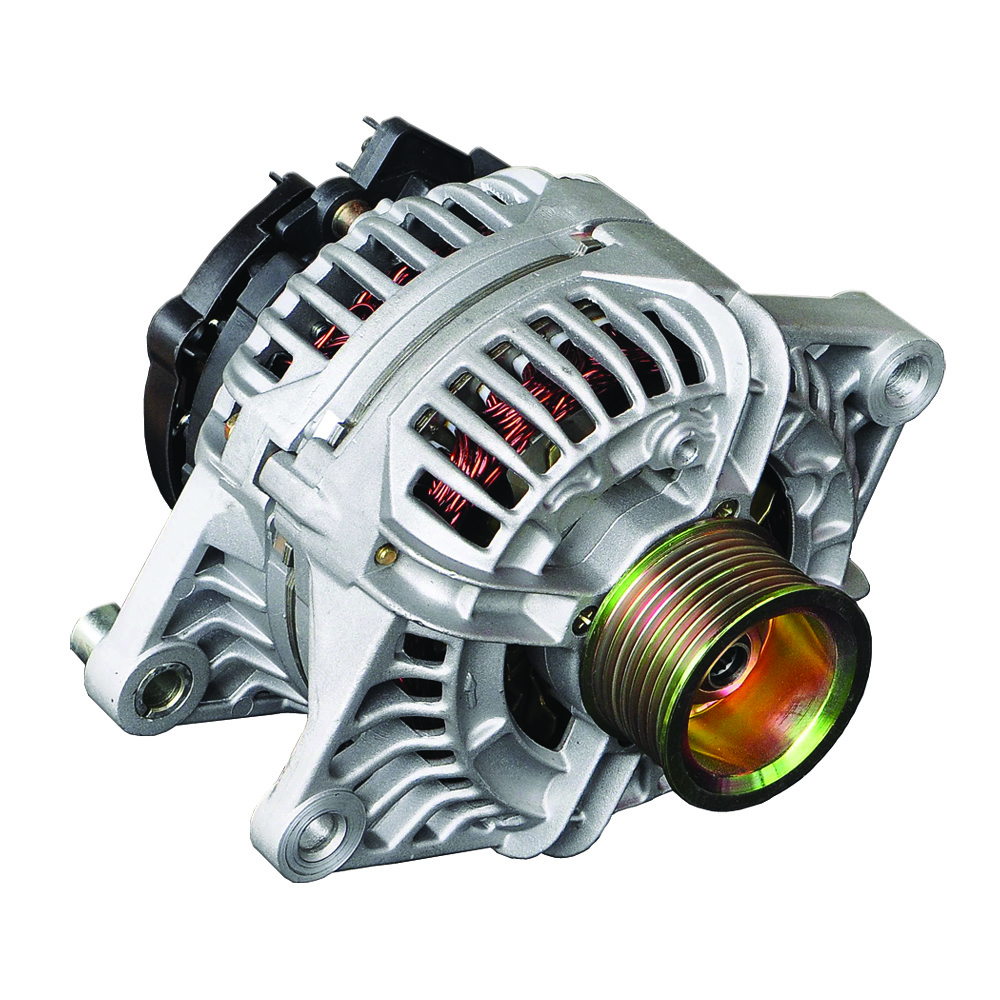Last Update: August 21, 2019

The short answer is, no, electric cars do not have an alternator. They do not need an alternator, since the car keeps the 12 volt battery charged through other means.
What does a gasoline/diesel-powered car alternator do?
An alternator is an electrical generator that converts mechanical energy to electricity in the form of alternating current. This means to charge the 12 volt starter battery it has to be converted to DC and managed with a charge regulator. The picture above is a typical car alternator.
The alternator is usually mounted on a bracket connected to the engine. It is connected to the engine such that the alternator turns when the engine is turning, so that it generates electricity the whole time the car is running.
Why don't electric cars have alternators?
Remember the purpose of the alternator is keeping the 12 volt battery charged. In an all-electric car, the 12 volt battery is kept charged through a device known as the DC-DC converter.
DC-DC converters exist in all kinds of electrical gadgets. The name tells you what it does, namely it converts one DC voltage to another. DC-DC converters are designed for every kind of voltage combination and power requirement. In an electric car it must convert from the main battery pack voltage, typically about 400 volts, to the voltage required to charge the 12 volt battery.
This satisfies the requirement - charge the 12 volt battery - with a much simpler piece of equipment, that is far more reliable than an alternator.
In short, an alternator is simply not required in an electric car because the purpose it would fulfill is satisfied using the DC-DC converter.
Can an alternator power an electric car? Why isn't there an alternator to keep the main battery charged?
There are many questions like that which are asked about electric cars. It's as if people are trying to fit their gasoline car knowledge around an electric car, but it doesn't fit.
There is two kinds of cars that have an electric motor and a gasoline (or diesel) engine driving a generator. They are the traditional hybrid car, and the plug-in hybrid car. See
- What is the difference between traditional Hybrid, Plug-in Hybrid, or All-Electric battery-electric vehicles?
- Why an electric car can’t power itself
In a traditional hybrid car, a small battery pack holds enough electricity so the car can drive electrically for short distances. For example at a stop-light the gas engine can shut down, then when the light turns green the car can take off on electricity and switch to gasoline power after a few hundred yards. If designed well the car has a much higher miles/gallon (MPG) rating than a traditional gasoline car. But the battery pack cannot be recharged from the electric grid.
A plug-in hybrid car is roughly similar but with a larger battery pack allowing for 20 or 40 or 80 miles of electric driving range. The PHEV battery pack can be recharged from the electric grid, and can also be charged from the gasoline engine.
In both cases there is a generator that is used for recharging the battery pack. So yes, there are electrified cars that have generators. Note: "electrified" not "all electric". But an "ALL ELECTRIC" car, one that only has a battery pack and no gasoline engine, simply does not have an on-board generator to recharge the battery pack.
But, some folks object, what if a generator were attached to the wheels and generated power as the car rolls down the road?
Sigh. I wish these people would have paid attention in high school physics class. That suggestion is what's called a perpetual motion machine. According to the physics they teach in high school, perpetual motion machines are impossible.
The reason for this is an alternator, or any other kind of generator, robs some of the mechanical power that keeps the car moving. This is doubly so if the generator is attached to the wheels. At the risk of oversimplification let's say this: It inevitably takes more energy to drive the generator than the electricity it generates. Any attempt to do this will result in an electric car that slowly grinds to a halt.


